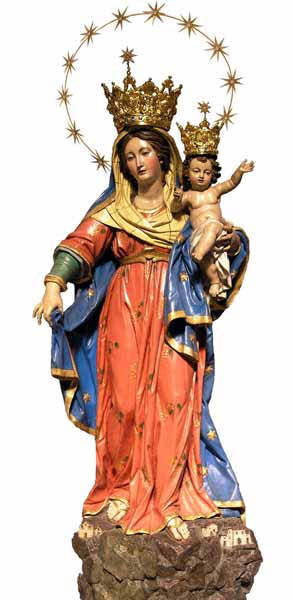Maria SS. of Portosalvo
Patron of Siderno
 Undisputed masterpiece of beauty, bathed in supernatural grace, wooden statue of the patron must be ascribed to the intense production of statuary Neapolitan widely documented in Calabria. We do not know exactly the name of its sculptor, nor the precise date of realization: unspecified sources speak of his arrival in Siderno occurred around 1819. The comparison with the rich catalog of Neapolitan sculpture on the diocesan territory escape, however, shadow of a doubt: the work, in fact, is among the most interesting, and the value for the executive and the state of conservation. The statue, in fact, enjoys a perfect readability thanks to the technical and aesthetic qualified conservation actions that have been submitted in fairly recent times. The first intervention, realized in 1985 by renowned restorer greek Dimitri Vakalis, readability gave back to the original colors overshadowed by two hands fake color, the last of which was appended by Fortunato in Salerno 1923 before the Coronation of the effigy. In 2002, due to the occurrence of repeated signs of infestation by wood-eating insects support and decoesioni of the paint film from the preparation, they proceeded to a second recovery phase initiated by Dr. Daniela Del France, which provided, also, to ensure the solidity of the wooden structure with the insertion of three self-tapping screws to medium depth in such a way as to ensure the tightness of the statue on the platform.
Undisputed masterpiece of beauty, bathed in supernatural grace, wooden statue of the patron must be ascribed to the intense production of statuary Neapolitan widely documented in Calabria. We do not know exactly the name of its sculptor, nor the precise date of realization: unspecified sources speak of his arrival in Siderno occurred around 1819. The comparison with the rich catalog of Neapolitan sculpture on the diocesan territory escape, however, shadow of a doubt: the work, in fact, is among the most interesting, and the value for the executive and the state of conservation. The statue, in fact, enjoys a perfect readability thanks to the technical and aesthetic qualified conservation actions that have been submitted in fairly recent times. The first intervention, realized in 1985 by renowned restorer greek Dimitri Vakalis, readability gave back to the original colors overshadowed by two hands fake color, the last of which was appended by Fortunato in Salerno 1923 before the Coronation of the effigy. In 2002, due to the occurrence of repeated signs of infestation by wood-eating insects support and decoesioni of the paint film from the preparation, they proceeded to a second recovery phase initiated by Dr. Daniela Del France, which provided, also, to ensure the solidity of the wooden structure with the insertion of three self-tapping screws to medium depth in such a way as to ensure the tightness of the statue on the platform.
The aesthetic features of the image are clear and enforceable: The Virgin, portrayed in a position of incipient movement, is structured on a meticulous study of the pondus that finds a perfect match in the gestures. The right leg is retracted his left arm brought inside to support the Child Jesus; vice versa, the left leg stretched forward pendant makes the movement of the right arm that extends under the cloak pitifully small houses at his feet. The expression, changing, is sometimes maternally tender, smiling, almost speaking from one side, other severe and sad, penetrating, even pleading. Inspire, however, a sense of superhuman beauty, of grace Arcadian, bathed as it is by the aura of simplicity, of immediacy that seems to reassure, protect, welcome. The Child, enthroned on the breast, is carved with care and a wealth of details that highlight the anatomy of early childhood, the delicate, very human movements of a creature in his mother's arms.
The kingship that emerges from the work is, therefore, mediated by the sweetness of executive features: the image is presented, that, to the faithful in the complex iconography of Mother and Queen, under whose mantle the City symbolically takes refuge in an eternal gesture of love and filial entrusting.
© Description by Dr. Gianfrancesco Solferino